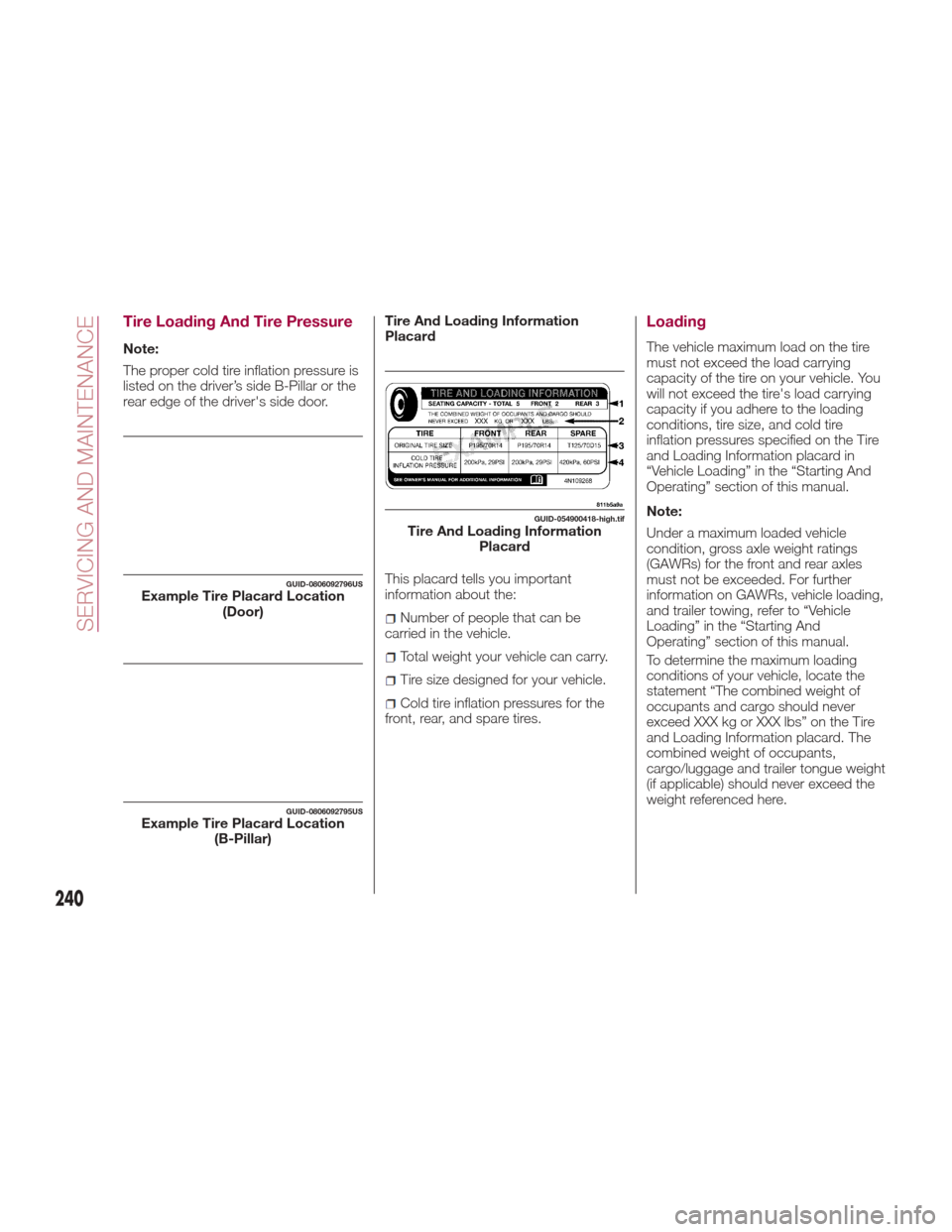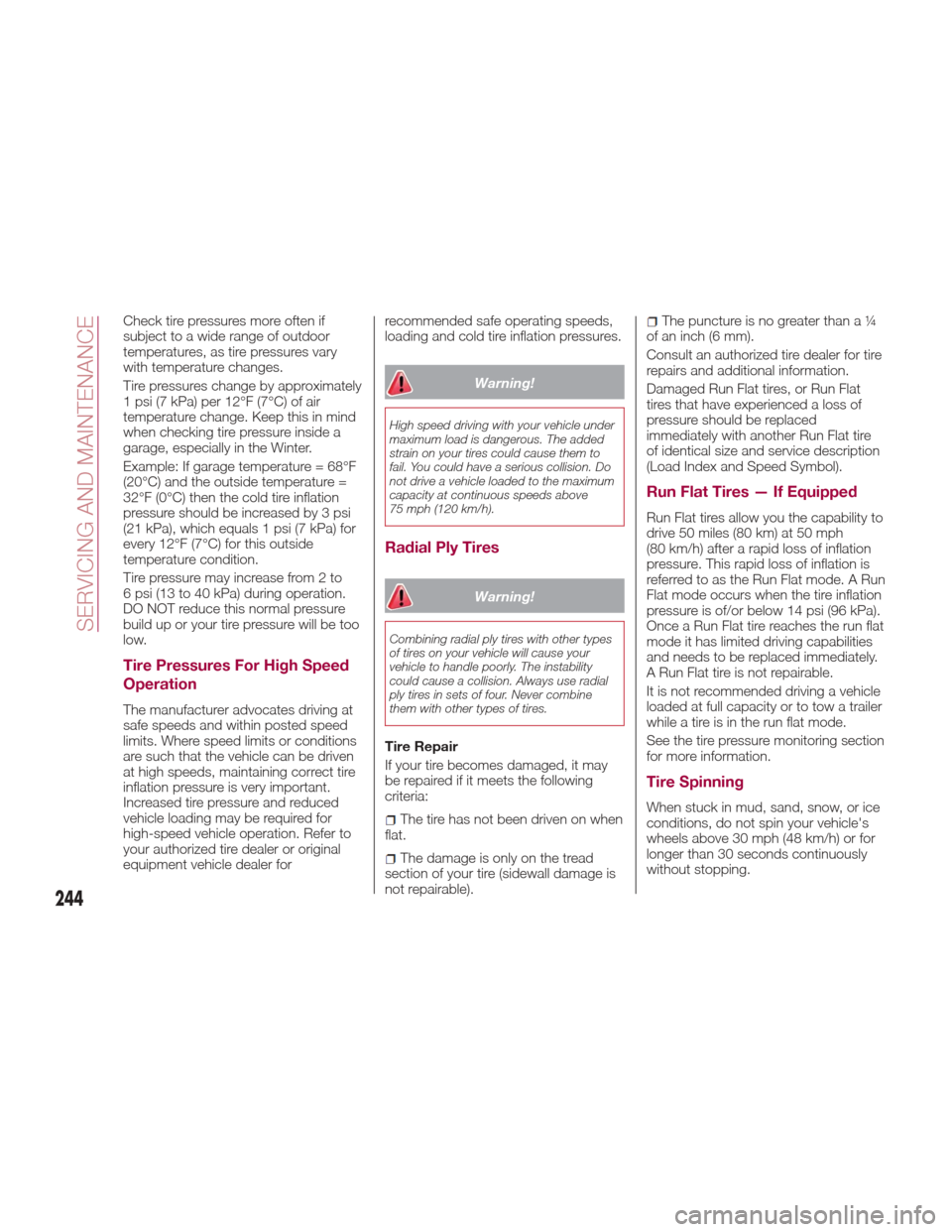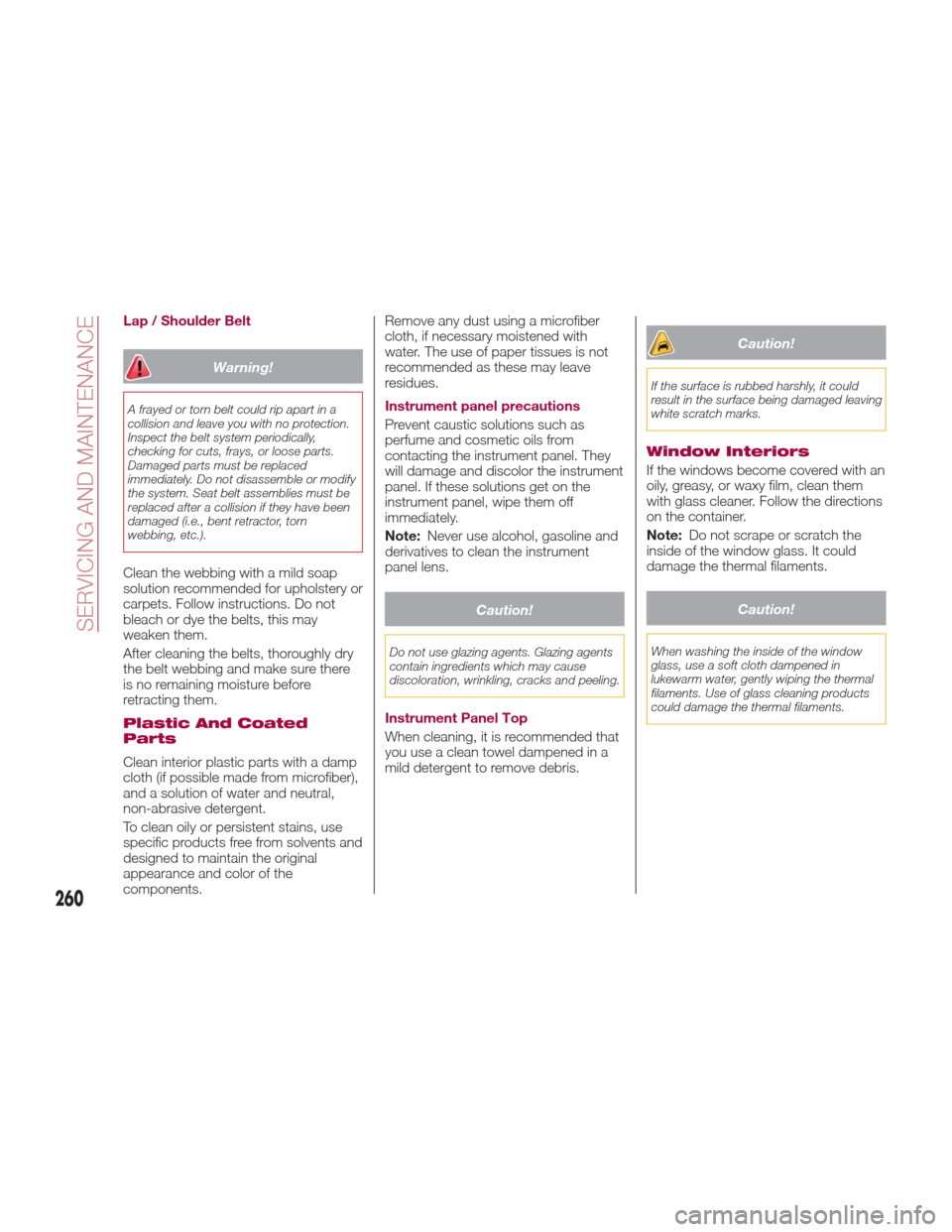2017 FIAT 124 SPIDER ABARTH tow
[x] Cancel search: towPage 242 of 292

Tire Loading And Tire Pressure
Note:
The proper cold tire inflation pressure is
listed on the driver’s side B-Pillar or the
rear edge of the driver's side door.Tire And Loading Information
Placard
This placard tells you important
information about the:
Number of people that can be
carried in the vehicle.
Total weight your vehicle can carry.
Tire size designed for your vehicle.
Cold tire inflation pressures for the
front, rear, and spare tires.
Loading
The vehicle maximum load on the tire
must not exceed the load carrying
capacity of the tire on your vehicle. You
will not exceed the tire's load carrying
capacity if you adhere to the loading
conditions, tire size, and cold tire
inflation pressures specified on the Tire
and Loading Information placard in
“Vehicle Loading” in the “Starting And
Operating” section of this manual.
Note:
Under a maximum loaded vehicle
condition, gross axle weight ratings
(GAWRs) for the front and rear axles
must not be exceeded. For further
information on GAWRs, vehicle loading,
and trailer towing, refer to “Vehicle
Loading” in the “Starting And
Operating” section of this manual.
To determine the maximum loading
conditions of your vehicle, locate the
statement “The combined weight of
occupants and cargo should never
exceed XXX kg or XXX lbs” on the Tire
and Loading Information placard. The
combined weight of occupants,
cargo/luggage and trailer tongue weight
(if applicable) should never exceed the
weight referenced here.
GUID-0806092796USExample Tire Placard Location (Door)
GUID-0806092795USExample Tire Placard Location(B-Pillar)
GUID-054900418-high.tifTire And Loading InformationPlacard
240
SERVICING AND MAINTENANCE
Page 243 of 292

Steps For Determining Correct
Load Limit—
(1) Locate the statement “The
combined weight of occupants and
cargo should never exceed XXX kg
or XXX lbs.” on your vehicle's
placard.
(2) Determine the combined weight
of the driver and passengers that
will be riding in your vehicle.
(3) Subtract the combined weight of
the driver and passengers from XXX
kg or XXX lbs.
(4) The resulting figure equals the
available amount of cargo and
luggage load capacity. For
example, if “XXX” amount equals
1400 lbs. and there will be five
150 lb passengers in your vehicle,the amount of available cargo and
luggage load capacity is 650 lbs.
(1400-750 (5x150) = 650 lbs.)
(5) Determine the combined weight
of luggage and cargo being loaded
on the vehicle. That weight may not
safely exceed the available cargo
and luggage load capacity
calculated in Step 4.
(6) If your vehicle will be towing a
trailer, load from your trailer will be
transferred to your vehicle. Consult
this manual to determine how this
reduces the available cargo and
luggage load capacity of your
vehicle.
Metric Example For Load Limit
For example, if “XXX” amount equals
635 kg and there will be five 68 kg passengers in your vehicle, the amount
of available cargo and luggage load
capacity is 295 kg (635-340 (5x68) =
295 kg) as shown in step 4.
Note:
If your vehicle will be towing a trailer,
load from your trailer will be transferred
to your vehicle. The following table
shows examples on how to calculate
total load, cargo/luggage, and towing
capacities of your vehicle with varying
seating configurations and number and
size of occupants. This table is for
illustration purposes only and may not
be accurate for the seating and load
carry capacity of your vehicle.
For the following example, the
combined weight of occupants and
cargo should never exceed 865 lbs
(392 kg).
241
Page 246 of 292

Check tire pressures more often if
subject to a wide range of outdoor
temperatures, as tire pressures vary
with temperature changes.
Tire pressures change by approximately
1 psi (7 kPa) per 12°F (7°C) of air
temperature change. Keep this in mind
when checking tire pressure inside a
garage, especially in the Winter.
Example: If garage temperature = 68°F
(20°C) and the outside temperature =
32°F (0°C) then the cold tire inflation
pressure should be increased by 3 psi
(21 kPa), which equals 1 psi (7 kPa) for
every 12°F (7°C) for this outside
temperature condition.
Tire pressure may increase from 2 to
6 psi (13 to 40 kPa) during operation.
DO NOT reduce this normal pressure
build up or your tire pressure will be too
low.
Tire Pressures For High Speed
Operation
The manufacturer advocates driving at
safe speeds and within posted speed
limits. Where speed limits or conditions
are such that the vehicle can be driven
at high speeds, maintaining correct tire
inflation pressure is very important.
Increased tire pressure and reduced
vehicle loading may be required for
high-speed vehicle operation. Refer to
your authorized tire dealer or original
equipment vehicle dealer forrecommended safe operating speeds,
loading and cold tire inflation pressures.
Warning!
High speed driving with your vehicle under
maximum load is dangerous. The added
strain on your tires could cause them to
fail. You could have a serious collision. Do
not drive a vehicle loaded to the maximum
capacity at continuous speeds above
75 mph (120 km/h).
Radial Ply Tires
Warning!
Combining radial ply tires with other types
of tires on your vehicle will cause your
vehicle to handle poorly. The instability
could cause a collision. Always use radial
ply tires in sets of four. Never combine
them with other types of tires.
Tire Repair
If your tire becomes damaged, it may
be repaired if it meets the following
criteria:
The tire has not been driven on when
flat.
The damage is only on the tread
section of your tire (sidewall damage is
not repairable).
The puncture is no greater than a ¼
of an inch (6 mm).
Consult an authorized tire dealer for tire
repairs and additional information.
Damaged Run Flat tires, or Run Flat
tires that have experienced a loss of
pressure should be replaced
immediately with another Run Flat tire
of identical size and service description
(Load Index and Speed Symbol).
Run Flat Tires — If Equipped
Run Flat tires allow you the capability to
drive 50 miles (80 km) at 50 mph
(80 km/h) after a rapid loss of inflation
pressure. This rapid loss of inflation is
referred to as the Run Flat mode. A Run
Flat mode occurs when the tire inflation
pressure is of/or below 14 psi (96 kPa).
Once a Run Flat tire reaches the run flat
mode it has limited driving capabilities
and needs to be replaced immediately.
A Run Flat tire is not repairable.
It is not recommended driving a vehicle
loaded at full capacity or to tow a trailer
while a tire is in the run flat mode.
See the tire pressure monitoring section
for more information.
Tire Spinning
When stuck in mud, sand, snow, or ice
conditions, do not spin your vehicle's
wheels above 30 mph (48 km/h) or for
longer than 30 seconds continuously
without stopping.
244
SERVICING AND MAINTENANCE
Page 262 of 292

Lap / Shoulder Belt
Warning!
A frayed or torn belt could rip apart in a
collision and leave you with no protection.
Inspect the belt system periodically,
checking for cuts, frays, or loose parts.
Damaged parts must be replaced
immediately. Do not disassemble or modify
the system. Seat belt assemblies must be
replaced after a collision if they have been
damaged (i.e., bent retractor, torn
webbing, etc.).
Clean the webbing with a mild soap
solution recommended for upholstery or
carpets. Follow instructions. Do not
bleach or dye the belts, this may
weaken them.
After cleaning the belts, thoroughly dry
the belt webbing and make sure there
is no remaining moisture before
retracting them.
Plastic And Coated
Parts
Clean interior plastic parts with a damp
cloth (if possible made from microfiber),
and a solution of water and neutral,
non-abrasive detergent.
To clean oily or persistent stains, use
specific products free from solvents and
designed to maintain the original
appearance and color of the
components.Remove any dust using a microfiber
cloth, if necessary moistened with
water. The use of paper tissues is not
recommended as these may leave
residues.
Instrument panel precautions
Prevent caustic solutions such as
perfume and cosmetic oils from
contacting the instrument panel. They
will damage and discolor the instrument
panel. If these solutions get on the
instrument panel, wipe them off
immediately.
Note:
Never use alcohol, gasoline and
derivatives to clean the instrument
panel lens.
Caution!
Do not use glazing agents. Glazing agents
contain ingredients which may cause
discoloration, wrinkling, cracks and peeling.
Instrument Panel Top
When cleaning, it is recommended that
you use a clean towel dampened in a
mild detergent to remove debris.
Caution!
If the surface is rubbed harshly, it could
result in the surface being damaged leaving
white scratch marks.
Window Interiors
If the windows become covered with an
oily, greasy, or waxy film, clean them
with glass cleaner. Follow the directions
on the container.
Note: Do not scrape or scratch the
inside of the window glass. It could
damage the thermal filaments.
Caution!
When washing the inside of the window
glass, use a soft cloth dampened in
lukewarm water, gently wiping the thermal
filaments. Use of glass cleaning products
could damage the thermal filaments.
260
SERVICING AND MAINTENANCE
Page 286 of 292

INDEX
About Your Brakes...........149
ABS system ............... .111
Active Adaptive Shift (AAS) ......155
Adaptive Front Lighting System (AFS) ...................42
Additives, Fuel ..............173
Advanced Keyless Entry System Key Left In Trunk ............22
Key left In Vehicle ...........22
Locking Doors .............22
Passive Entry ..............22
Request Switch ............22
Unlocking Doors ............22
AirBag............... .132,136
Advance Front Air Bag . . . .132,136
Air Bag Warning Light .......146
Event Data Recorder (EDR) . . . .145
FrontAirBag ............ .146
Maintaining Your Air Bag
System ............... .145
Air Bag Maintenance ..........145
Air Pressure, Tires ............243
Alarm Vehicle Security Alarm ......24,25
Alarm (Security Alarm) ........24,25
Aluminium wheel maintenance . . . .256
Automatic Dimming Mirror ........37
Automatic Headlights ...........40Automatic Temperature Control
(ATC) ...................52
Automatic Transmission ........152
Auxiliary Power Outlet ..........64
B-Pillar Location.............240
Battery (maintenance) ..........233
Battery charging procedure ......234
Battery recharging ............234
Blind Spot Monitoring ..........113
Body and underbody warranty . . . .252
Body lubrication .............234
Bodywork (care and maintenance). .252
Boot, Convertible Top Lowering ....70
Boot, Convertible Top Precautions . .73
Boot, Convertible Top Raising .....72
Brake System ...............149
Brake/clutch fluid (level check) . . . .232
Brakes ............... .149,268
Bright-metal maintenance .......256
Camera, Rear..............166
Carbon Monoxide Warning ......173
Center Seat Storage Compartment ..............61
Certification Label ............175
Changing A Flat Tire .....202,203,237
Checking levels ..............230
Child Restraint ..............128
Child Restraints Child Restraints ...........128 Clean Air Gasoline
............172
Climate Control ..............44
Close The Hood ..............70
Compact Spare Tire ...........247
Contract, Service ............281
Convertible Top ..............70
Convertible top maintenance .....257
Cooling Air Conditioning ............50
Cupholders .................65
Customer Assistance ..........280
Data Recorder, Event.........145
Daytime Running Lights .........40
Diagnostic System, Onboard ......77
Dimensions ............... .271
Disabled Vehicle Towing .....220,221
Driver's Seat Back Tilt ..........33
Driving in flooded area .........180
Driving tips ............... .177
Electric power steering.........74
Electric Remote Mirrors .........38
Electromagnetic Compatibility . . . .277
Electronic Brake Control System Traction Control System ......111
Electronic Speed Control (Cruise Control) ............157
Electronic Vehicle Information Center (EVIC)
Electronic Vehicle Information
Center (EVIC) ..............78
INDEX
Page 287 of 292

Electronic Vehicle Information
Center (EVIC) Setup Menu.....78
EVIC Display ..............78
Emergency flap opening ........174
Emergency Key ..............19
Emergency, In Case Of .........207
Hazard Warning Flasher ......183
Jacking ..........202,203,237
Jump Starting ............217
Overheating .............219
Towing ............. .220,221
Emission control system .........75
Engine .................. .266
Exhaust Gas Caution ........173
Fails To Start .............218
Flooded, Starting ..........218
Jump Starting ............217
Overheating .............219
Starting ..............21,218
Engine compartment ..........230
Engine coolant (level check) ......231
Engine oil (level check) .........231
Environment protection systems ....75
Essential information ............3
Ethanol .................. .172
Event Data Recorder ..........145
Exhaust Gas Caution ..........173
Exterior Lights ...............38Flash-To-Pass...............40
Flashers Hazard Warning ...........183
Turn Signal ...............41
Flooded Engine Starting ........218
Fluid And Lubricants ..........274
Fluid Capacities .............273
Fog Lights ..................41
Follow Me Home .............41
Front lights (light bulbs) .........186
Front Wipers Wiper Operation ...........42
Fuel Additives ...............173
Clean Air ...............172
Ethanol ............... .172
Materials Added ...........173
Methanol ...............172
Fuel Consumption Display ........88
Fuel Economy Monitor ..........87
Fuel filler cap ...............174
Fuel filler door ...............173
Fuse block (engine compartment) . .196
Fuse block (interior) ...........200
Fuses (interior) ..............194
Fuses (underhood) ............195
Gasoline, Clean Air...........172
Gasoline, Reformulated ........172Gear selector positions
.........153
GVWR .................. .175
Hazard Warning Flasher........183
Hazardous driving ............177
Head Restraints ............34,35
Headlight ..................38
Headlights Adjusting The Headlight
Abroad..................42
High Beam ...............40
Passing .................40
Heavy-duty use of the vehicle (scheduled servicing) ........224
HomeLink (Garage Door Opener) ........59
Hood Release ...............69
How to use this manual ..........3
Identification Data............263
Inside Rearview Mirror ..........36
Instrument Cluster Display DID Menu Items . . . .79,80,82,83,84
EVIC Menu Items . . .79,80,82,83,84
Interior Lights ................63
Interiors ................. .259
Internal Equipment ............61
Jack Location..............202
Jack Operation ........202,203,237
Jump Starting ...............217
Page 288 of 292

Key Fob..................14
Emergency Key ............14
Programming Additional Key
Fobs ...................24
Key-In Reminder ..............21
Keyless Entry System...........15
Lane Change And Turn Signals ....41
Lane Change Assist ............41
Lap/Shoulder Belts ........123,125
Leaving Home Light System ......42
Life Of Tires ............... .245
Lights Daytime Running ...........40
Fog ...................41
Hazard Warning Flasher ......183
Passing .................40
Turn Signal ...............41
Loading Vehicle .............175
Tires ................. .240
Locks PowerDoor ........... .26,31
Maintaining the finish.........254
Maintenance Monitor ...........85
Maintenance procedures ........234
Manual Climate Control System ....48
Heating .................50
Manual transmission ..........151
Manual Transmission ..........151Manual, Service
.............283
Methanol ................. .172
Mirrors....................36 Automatic Dimming .........37
Electric Remote ............38
Exterior Folding ............38
Outside .................36
Rearview ................36
Occupant Restraints ..........122
Onboard Diagnostic System ......77
Operating Precautions ..........77
Outside Rearview Mirrors ........36
Overhead light (bulb replacement) . .193
Overheating, Engine ...........219
Overloading ............... .181
Owner's Manual (Operator Manual) ..........283
Paint damage touch-up ........256
Parking Brake ...............150
Passing Light ................40
Performance ...............276
Periodic checks (scheduled servicing) ............... .224
Personal Settings ............107
Personalization Features ........107
Placard, Tire And Loading Information ...............240
Plastic part maintenance ........258Power
Brakes ................ .149
Door Locks ............26,31
Mirrors .................38
Pregnant Women And Seat Belts . .124
Pretensioners Seat Belts ..............127
Protection from atmospheric agents (bodywork) ..........252
Radar Sensors.............160
Radial Ply Tires ..............244
Radio Frequency General Information ........20,23
Radio transmitter and mobile phones ...................5
Rear Camera ...............166
Rear lights (light bulbs) .........186
Rear Park Assist System ........161
Rearview Mirrors ..............36
Recommended Tire Inflation Pressure ............... .264
Recorder, Event Data ..........145
Recreational towing ...........176
Reformulated Gasoline .........172
Refueling procedure ...........173
Refueling the vehicle ..........171
Reminder, Seat Belt ...........127
Replacement Tires ............246
Replacing a bulb .............183
INDEX
Page 290 of 292

Quality Grading...........251
Radial ................ .244
Replacement .............246
Safety ..............237,243
Snow Tires ..............247
Spare Tire .........202,247,248
Spinning ...............244
Tread Wear Indicators .......245
ToOpenDeckLid.............66
ToOpenHood...............69
Towing Disabled Vehicle ........220,221
Towing Eyes ............... .220
Towing trailers ..............176
TPMS (Tire Pressure Monitoring System) ................ .118Transmission
...............267
Tread Wear Indicators ..........245
Trunk Lid Closing ..................68
Opening .................66
Trunk light (bulb replacement) .....193
Turn Signals .................41
Undercoating ..............256
Uniform Tire Quality Grades ......251
Vehicle Loading..........175,240
Vehicle modifications/alterations .....4
Vent Operation ...............45
Warning Flasher, Hazard .......183
Warranty Information ..........282
Washer Operation ...........42,44
Washers, Windshield ...........42Wheels and tires
.............237
Window and headlight washer fluid (level check) ..............233
Window interiors (cleaning) ......260
Windows Driver/Passenger Window
Controls .................56
Power Windows ...........56
Window Lockout ...........58
Windshield wiper blades (replacing) ...............235
Windshield Wipers ............42
Windstop ..................66
Winter driving ...............178
Wiper blades ...............235
Wrecker Towing ..........220,221
INDEX